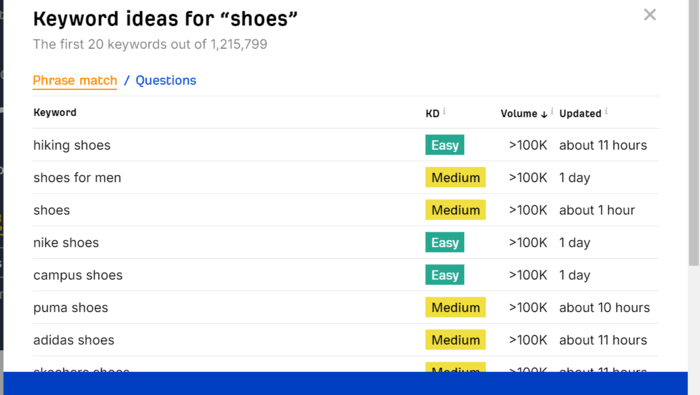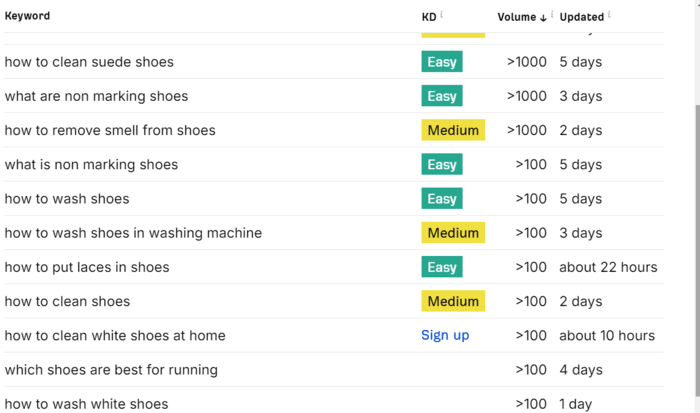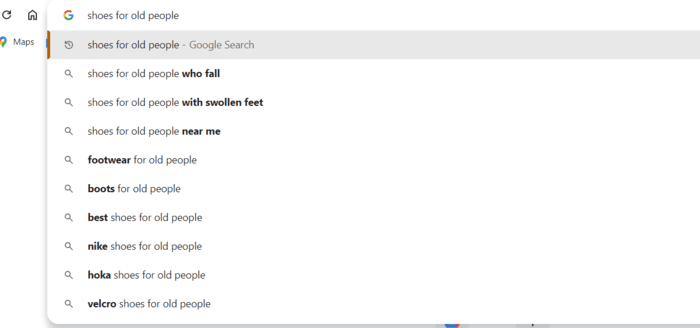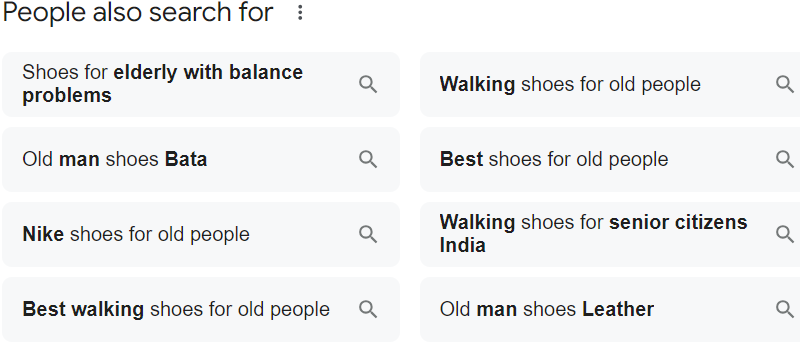
As a mentor, I often come across blogs and articles missing the most crucial ingredient: intent.
Being specific is one way to let your readers and the search engine know what your intent behind creating content.
Curious about why so many writers overlook this essential aspect of content, I discovered a common mistake made during the keyword research stage—choosing seed keywords over long-tail ones.
Instead of going in circles, I would love to address the elephant in the room.
So, what is a long tail keyword in SEO?
Let me explain that to you first and then I will help you understand why they matter, and how you can use them strategically to boost your content’s visibility and drive targeted traffic to their site.
Let’s dig in!
What is a long tail keyword in SEO?
Long-tail keywords are super-specific search queries. They are low volume and low in competition.
But wait!
It’s not only about the number. You can identify a long-tail keyword when it focuses on a specific topic rather than a broad one.
In short, long tail keywords are longer and more specific phrases or terms that help you to target a niche audience.
Let me help you understand it with an easy example: “Gluten-free vegan pizza recipes with almond flour”
The seed keyword here would be “pizza recipes,” which is broad and could apply to countless variations.
The long-tail keyword “gluten-free vegan pizza recipes with almond flour” is much more specific, targeting a niche audience looking for a particular type of recipe. This makes it less competitive but more relevant to users searching for that exact type of content.
Why is it not a good idea to ignore long tail keywords?
There are so many benefits of using long-tail keywords in your content. Let’s learn about them in detail.
- It’s easier for you to create comprehensive content
Creating content with long tail keywords becomes easier as the search term and its intent are super specific.
At the same time, you can create comprehensive content focusing on a specific topic. For example, if a client asks me to write a blog or an article on “chairs” my focus may go haywire as there are enumerable options (reclining chairs, office chairs, dining chairs, luxury dining chairs, etc.).
But if they ask me to write about “wooden rocking chairs for elderlies”, I would not rack my brain thinking where to start, where to end, or what to write about.
It’s specific, and the intent is clear. It is transactional. The customer is looking for a comfortable chair for elderly people. They may be looking to purchase one or compare different types available in the market.
They are looking for comfort, sturdiness, reviews, recommendations, and the best place near them to buy the product.
That means I now know the points I must address while writing my content.
- The competition is low
Long tail keywords are very low in competition. As per Search Engine Land, they are used by 70% of the searchers. Long tail keywords are easier to rank compared to their short tail counterpart. Short tail keywords account for only 30% of the search Not using them means missing out on attracting your audience.
- Better conversion rates
Long tail keywords are used to curate content on specific information. Because of that, the content is more relevant and that helps companies experience higher conversion rates.
Let me help you understand it by using this example. If you want to buy running shoes online using the search query “running shoes”, you will be overwhelmed by Google’s results.
But if you use the search term “best lightweight running shoes for marathon training”, you will get more targeted results. Searching with a specific term will increase your chances of finding what you want and save time.
- Long-tail keywords help you rank for short-tail ones
Long tail keywords also contain seed keywords or short tail keywords. For example “best lightweight running shoes for marathon training” has the seed keyword “running shoes” in it.
This combination of keywords allows you to target general and specific queries.
- Works better for voice search
While doing voice searches most people go for long tail keywords. Because in that case, people use queries that they use in real conversation. So, when you include these keywords, you draw these users to your website as your content caters to exactly what they need.
How to find long-tail keywords?
While searching for the perfect longtail keywords, I follow these steps:
Step 1
I use Ahrefs Free Keyword Generator and type a broad seed keyword.

I mostly go to the questions and find more specific ones.

These are more specific queries with low competition.

Step 2
I get the related keywords from Google search features like Google Auto Search, People Also Ask and People Also Search for.



Step 3
Once I have finalized my focus keyword, I enter it into the Google search, check the first 5 or 6 competitors, and find out what possible keywords I still need to include. if I find a subtopic that I have not yet included in my keyword list, I immediately note that down.
Step 4
Forum sites like Quora and Reddit are great places to get long-tail keywords.

Step 5
Finally, I arranged these keywords into a list that includes 1 focus keyword, 5 secondary keywords, and 5 related keywords.
I use different free tools to find long-tail keywords. Here are some of them:
- Ahrefs Free Keyword Generator
- Ask the public
- Also Ask
- Keyword tool
- Google auto-suggest
- Google People Also Ask
Focus on intent & serve your audience what you promised
Only using long-tail keywords is not going to guarantee top ranking. You need to focus on the search intent of that keyword and create content accordingly. Think about what you have promised to your readers, serve exactly that.
It’s not what you want to say, it’s what they want to read. You need to think in terms of INTENT. It can be informational intent (where the reader simply wants information (eg. what is a long tail keyword in SEO), navigational content (the reader searching a particular website or webpage, eg. Facebook login page), commercial intent (the reader is researching before buying, eg. best dark lipstick), or transactional (decision taken, now the user wants to buy, eg. buy Jyoti’s Apple Watch).
Apart from that, you need to put the focus keyword and the others in the meta title, meta description, URL, and also header tags.
Staying true to the intent and adopting a great keyword strategy will help you reach the right users.
In case you have any queries, you can use the comment section and shoot them to me.
My aim behind writing these pieces is to help you grow as an SEO writer and learn and share each other’s unique experiences.
If you are new to SEO and content writing, you can check my detailed blogs on them here:
